Meant to compete with the best that American auto manufacturers had to offer at the time – Imperial, Lincoln, and Cadillac – Packard took a big swing at the competition, and the 1956 Packard Four Hundred was it – at least for two-door hardtop cars. The seller has this luxury coupe listed here on eBay in Gloversville, New York and they have an $18,900 buy-it-now price listed.
The Packard Four Hundred only came in this two-door hardtop body style. If a buyer wanted two more doors in a top-line Packard they had to step into the Patrician line. Either way, they were incredibly luxurious cars but they weren’t without a few nagging issues. The two-speed Twin Ultramatic transmission was somewhat problematic as was the method of gear selection: the push-button shifter. Still, these were incredibly nice, smooth, quiet cars.
The Packard Four Hundred, a senior line of Packards, was previously a top trim level for the 1951 and 1952 Packard Patrician four-door sedan but was written numerically as “400” rather than spelled out as “Four Hundred”. That trim level went away in 1953 but came back as the Four Hundred in only a two-door-hardtop bodystyle and became its own model within Packard’s senior line. The Four Hundred would be made as a two-door hardtop for 1955 and 1956 and then it was gone. In two short, Packard would itself be gone.
The seller says that it had one repaint in its original colors about eighteen years ago but the body panels and floors are original. There are a couple of underside photos but it’s hard to tell the condition. They say that it was an Arizona car before moving to New York and this car “has NEVER been driven in winter snow and salt!” The interior looks almost like new and there is no mention if it’s original or has been restored. If those beautiful seats are original that’s amazing, they look perfect both front and rear, as does the cavernous trunk compartment.
The engine and engine compartment appear to be whistle-clean and that should be Packard’s 374 cubic-inch V8 which was rated at 290-hp and a romping 405 lb-ft of torque. This gorgeous car “runs and drives great! No abnormal leaks, noises, or smoking. Engine and transmission are smooth, tight, and powerful. Drives, rides, and handles great!” This looks like a fantastic example and for a reference, Hagerty is at $16,800 for a #3 good condition car and $30,100 for a #2 excellent car. Have any of you owned a Packard Four Hundred?
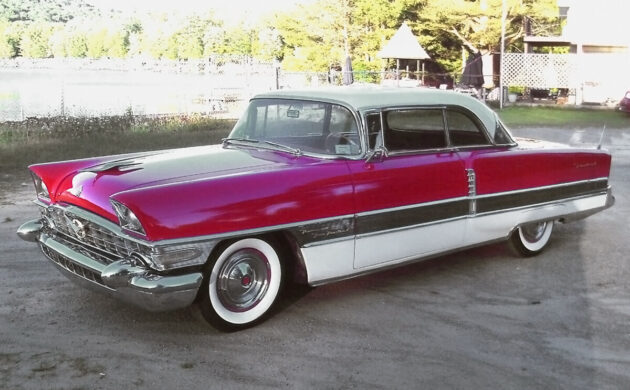
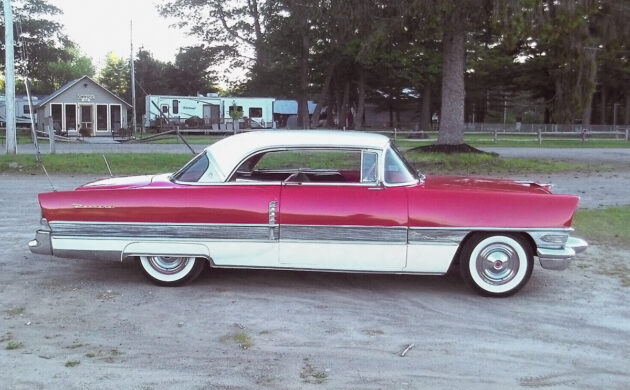
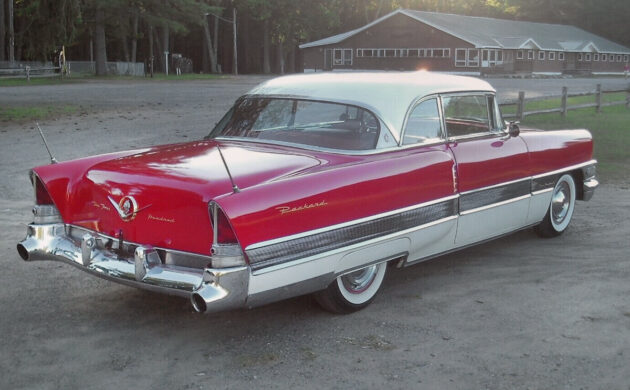
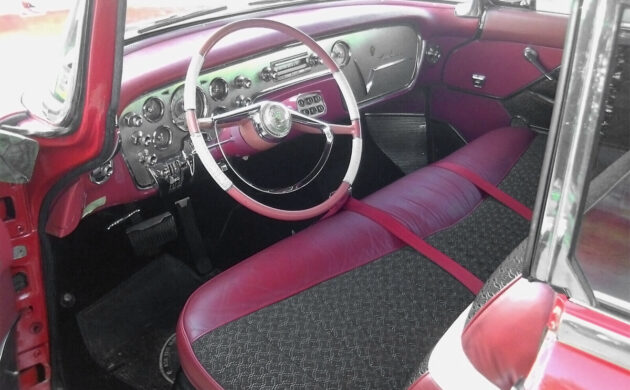
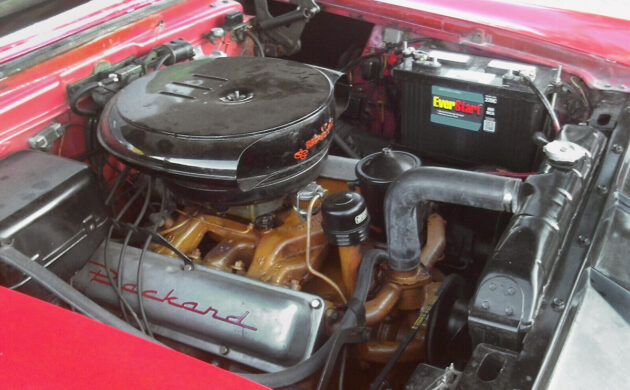


“Weee doggies” ( in my best Jed Clampett voice), that’s a sharp( est) car. If produced by any other car company( preferably a stable one), it would have been a huge success. It had it all. The author didn’t mention, and hope he doesn’t mind, the reason these cars rode so well, and I believe it was across the board( Bill?), was the “Torsion-Level”suspension, a joint effort from Allison and Packard. Other companies dabbled with air ride, but problematic, but the Packard was a simple arrangement of electric motors that individually adjusted torsion bars. It was touted as the BEST riding suspension ever. I know, a hefty claim, but remember, it was 1955. How the car remained like this is truly a testament to someones loyalty to Packard. I bet my grandfather, had he been a wealthier man, a simple upholsterer, would have bought one, but in 1955, his ’48 Custom 8 was still running great, with no need to replace it. Another “problem” Packard had. Their cars just lasted too dang long.
You know, the author does’t get emotional like I do, part of the writing job, I suppose. It’s why I’d make a lousy writer, wait, are there others like me? Maybe I’d make a good, “in your face” writer, not that the staff would go for that. Just the facts ( he never said “Ma’am”), but I look at this fantastic vehicle, $18,900, 104 “watchers” and NOT ONE BID? Go buy your rusty Bronco for cripes sakes,,,
I’m sorry Howard but I don’t see an option to bid on this car. It sets a classified ad price of $18,900, which sounds reasonable. Did I miss something? Is there an option to bid on the car?
Hi Mike, not sure about the bid thing,, didn’t even go that far, but with over 100 “watchers” and nobody bought the car, for whatever price, tells me people are curious, but just don’t have the grapes to stick $20g’s into a vehicle they probably know nothing about, and aren’t totally stupid. They know it will be a tough sell from here on out as more people that may have an interest fade away. I think, in the future, all these “orphaned” cars will be a tough sell. It’s happening already, and their loss.
In February,1977 I assisted a Packard trained mechanic rebuild a 1956 torsion bar suspension that ‘snapped’ and collapsed on Dixie hwy,West Palm Beach.
The ’55 & ’56 were different. This rust free, wealthy owner had owned it since new. You must know what you’re doing if one of the four? Torsion bars let go. Special Packard tools are required. Luckily we traveled to the giant car show in Pennsylvania that April and purchased 20 year old N.O.S. parts. I don’t see anyone touching these cars today.
Jean,
Yes, there are a total of 4 torsion bars on the V8 Packards, 2 long ones connecting to the front & rear wheels, and 2 short ones that are used to maintain correct ride height [electric motor twists them]. It’s the long bars that typically fail, due to a small batch of 1956 defective torsion bars that were not properly tempered by the supplier.
Today, it’s much easier to work on these suspensions, as reproduction sets of torsion bar installation and adjusting tools are available, as are the various “pins” that regulate the pre-load for the torsion bars.
As long as the mechanic understands the operation of this suspension system, and follows the repair manual instructions, they really are not difficult to repair with the correct tool sets.
That is an elegant looking car and has had a very well cared for existence. Not too many people want to be caretakers of this type of vehicle anymore. That’s a shame the 70’s and 80’s seem to be where the market is at, there are exceptions but as nice as this car is the collectors for these cars is getting thin. Hopefully this one finds another owner to care for it.
I’d love to buy this Packard. You don’t see many of these, in this good of condition, for a fair price. But, my garage is too full of rusty Broncos! Dang it!
Beautiful car, not like the crap they produce today. No real designers today imo.
Right on Gary and Howard A. Packard made among the finest, of not THE finest cars ever to come from a US factory. They were legendary regarding how they treated their associates as well as their dealers (up until 1955 that is). If they had continued, we likely would not have seen the likes of Lexus, Acura, Infiniti, etc., and BMW and Benz would be merely secondary competitors for the American luxury car buyer.
That’s one fine looking Packard. Both inside & out. Be nice if the seller would lose the “NeverStart” marine battery & replace it with a proper one. I know….picking nits.
Beautiful car but there is no real market for these anymore. Look at this baby, 955 Packard Clipper Super Panama, nice car and 5 bids to $1,655 now. https://www.ebay.com/itm/125406206629?_trkparms=amclksrc%3DITM%26aid%3D1110010%26algo%3DHOMESPLICE.DISCCARDS%26ao%3D1%26asc%3D240364%26meid%3Dcd941e34cf0a49eeb94f07b0dbe6b4f8%26pid%3D101110%26rk%3D1%26rkt%3D1%26sd%3D185489885340%26itm%3D125406206629%26pmt%3D0%26noa%3D1%26pg%3D2563228%26algv%3DDiscOrganicBase&_trksid=p2563228.c101110.m1982
No real market for them now and there wasn’t much of a market for them even then (3,224 built). Elegant cars but they were never seen on the road very often even back in the day. Always liked that little light behind the door on The Four Hundred that illuminated the fluted side trim when the headlights were on. Very cool when seen at night.
Paul in Ma,
The Clipper is also a lovely car, but to trying to compare it to the ’56 400 hardtop is like comparing a 1955 Pontiac Catalina hardtop with a 1956 Cadillac Coupe DeVille.
And yes, I would love to have both cars, and if I was 20 year younger I very well might have bought both!
Ironically, the convertible versions go for $8K in great condition. Sacrilege, but it would seem you could convert this to a convertible for another $20K or even less, including bracing, top hardware, etc and still be at half the price.
JohnfromSC,
I assume you had a Zero escape from your text, and you meant the convertibles [Caribbean] were going for $80k. Several V8 Caribbeans in semi or unrestored condition sold earlier this year at an auction in upstate NY for under $10k each.
The problems in converting a 400 hardtop to a convertible require finding a 1951 to 1954 Packard convertible for the top frame, back seat and the surrounding top well metal, and the shortened trunk lid. But even if you have all the ’51 to ’54 parts, there is still the matter of the windshield header, as it’s not the same. That has to be created by scratch, and as the parts were formed from castings and steel stampings, it’s not gonna be easy. The chrome vent window frames are also different, and require an additional piece at the top edge, but these can be made at a machine shop.
If it’s a 1956 400 hardtop as this car is, the seats are VERY different, as the Caribbean had special seat frames to hold the reversible seat bolsters, a 1956 Caribbean exclusive. The last time I heard about a full set of decent ’56 Caribbean seats & bolsters for sale, they were offered at about $15k.
And if you managed to create another Caribbean convertible from a 400 hardtop, the VIN’s 3rd & 4th digits will still indicate it’s a 400 hardtop.
A 400 will start with 5687 [the 8 denoting a senior Packard, the 7 denotes it’s a hardtop. A Caribbean is 5699, the 2 nines indicating it’s a Caribbean and convertible.
I’m not a red guy (but I don’t know if it’s the lighting or the camera but it’s almost got a hot pink tinge to it) But a bench seat, V8 and all that 50’s trim, and it’s only a 3 hour drive home. I might have to give this one some serious consideration. Like Howard said, I’d be one of those who knows nothing about it, besides how to spell Packard. But it does make me salivate.
Just maybe,
The actual red color of the car was called Scottish Heather, and it does have a touch of pink to the red. The color is quite striking in real life, these photos don’t do it justice. It’s actually my favorite V8 Packard color.
I’m attaching a photo showing what the color really looks like.
Howard, thanks for the call-out. The Torsion-Level system included 2 long torsion bars with their ends connected to the front and rear suspensions, so that a bump [upward force] at the front wheel would be transferred to the rear axle, basically transferring the force back down to the ground. There were 2 shorter torsion bars connected to the rear suspension. These 2 smaller bars could be tightened or loosened by way of a reduction gearbox and reversable electrical motor. This all operated using limit switches and a 7-second delay. The hydraulic brake switch also had a 3rd contact, to disconnect the leveling system during braking.
As for Allison, the name was in reference to a brilliant suspension engineer in Detroit, Mr. Bill Allison, who shopped the idea to several other manufacturers including Hudson, before Packard said yes.
Introduced in 1955, it really was a game-changer for suspension systems. Remember, back in the mid 1950s roads were nowhere as smooth as today, especially outside the cities. Torsion-Level made short work of rough road surfaces, and kept the car level even after 6 people and their luggage pilled into the car.
Packard produced a internal test video where it tested an early 1955 Packard Patrician with Cadillac and Lincoln sedans. They chose a terrible triple railroad grade crossing in Detroit, a road that most people slowed their car down to almost walking speed to traverse.
They drove the Packard over the tracks at about 25 mph, and while the front and rear wheels were bobbing up and down furiously, the body remained basically flat.
They drove the other “fine cars” over the crossing at the same speed. Both car’s bodies looked like a boat being tossed about in a huge storm. I don’t remember exactly what happened, but I think it was the Cadillac that lost it’s rear bumper, and the Lincoln’s engine oil pan was punctured. A CD of this amazing video is available from the Mid-Atlantic Packard Club as part of a fundraising project.
And FYI, The decision to use torsion-Level was the final death-knell for Henney, the makers of Packard commercial vehicles, as it would not be financially possible to create stretched chassis for the limousines, hearses and ambulances Henney made.
“Back in the mid 1950s roads were nowhere as smooth as today.”
You’re obviously not from Michigan.
In the 1950s Michigan’s roads were in much better condition and well maintained than they are nowadays.
Rick,
I stand corrected. “Back in the mid 1950s, except for Michigan, roads were nowhere as smooth as today.”
I was referring mostly to roads outside the city, where even in 1956 the vast majority of rural roads were unpaved. I’ve owned a 1956 Packard Patrician, 1956 Cadillac Fleetwood 60S, 1956 Imperial sedan, 1956 Lincoln Premier, and oh, yes, a 1956 Rolls-Royce Cloud.
Until I sold my farm in 2016, I lived on a private unpaved road. It was so bad at times some of my car friends wouldn’t drive their fully restored cars to the farm. The Packard could navigate rural roads with washboard surfaces and severe ruts, far faster and with less “bounce” than the other 4.
I really like this car. I feel that the asking price is fair. I’m not sure if this is an auction or not. In the full description it seems like the seller is entertaining offers. I’m sure you could call him/her to discuss. I am confused as to the number of gears in the transmission. The pictures show six buttons leading me to believe it is a four speed. I also find the comments about this car very interesting. I think that the observation that folks who are interested in a car like this are in decline is spot on. But it strikes me as curious that tri-five Chevrolets in this condition still have people throwing big bucks at them. When you go to a car meet or show you will still find quite a few but you can bet you will rarely see a Packard like this. And I agree with Howard; I would spend my money on something like this all day long instead of the rusty POS hulks that are available for just as much or more money than this. Go figure.
According to this website it was a 2-spd transmission. It sounds like trouble though if not adjusted properly. Who knows how to correctly adjust something this old?
https://auto.howstuffworks.com/1955-1956-packard-patrician-four-hundred-executive.htm
Carbob & Mikefromthehammer,
Packard did a major redesign of the Ultramatic for 1955 & 56, and it does have a low & high gearchange plus a lock-up torque converter [long before Ford announced their new concept of a lockup torque converter!], giving 3 forward speeds. Prior to that, the original Ultramatic operated more along the lines of the Buick Dynaflow.
And yes, there are shops around the country willing to work on these gearboxes, and while they were troublesome over the first 10 to 15 years of use, today there have been enough people rebuilding them who understand the original problems & limitations, and who have developed better materials and parts, to make them just as reliable as a 1950’s GM automatic trans.
The Twin Ultramatic trans was rushed into production so it could be introduced with the new V8. The original Ultramatic was believed too underrated for the new and more powerful engine, and they needed that new trans for the 1955 model year.
And the 1956 electric shift also had teething problems, there were tiny selection wires [known as fingers] that regulated where the shift motor would stop, and these fingers could get too hot and warp, or become corroded. All of these problems have been solved today, and there are rebuilt units available from Packard parts specialists. I was at the Packard Club National meet last week, and it’s amazing just how much in the way of spare parts, both mechanical and trim, are still available. Even a company that specializes in restoring the 1952-56 Bendix treadlevac power brake unit.
Thanks for all of the valuable information Bill.
A beautiful Packard to be sure. Not as desirable as the Caribbean but still a good contender. These mid-50s Packards along with most of the other independents of this era are loosing their cachet and hence value. I’m a Studebaker fan and really like the 55 President Speedster, likely the most desirable of the mid-50s Studebaker line.
The last true Packards (1955, 1956) suffered from problematic automatic transmissions which hasn’t helped their collectibility.
Even with current soft prices on 50s classics, this car seems like a bit of a bargain. It’s near the top of the Packard lineup for the time, doesn’t have too many doors, and the condition seems terrific. The nostalgia-driven buyers of cars of this era are aging out, leaving the more hardcore gearheads who appreciate vintage engineering for its own sake. It’s a smaller market, probably with fewer deep pocketed participants, and this car seems priced to appeal to these people. I’m tempted myself.
Thanks for the information, Bill. One of the best parts of Barn Finds is getting to learn from the many knowledgeable folks that participate in the comments section.
Carbob,
Thank you. I like to imagine life goes easier when we all have access to [and share] factual & accurate information, be it automotive, medical, or political!
If this car was offered 20 years ago, at a comparably low price, it would be MINE! Sadly, I’m having to rid myself of cars due to age and medical condition. My cars are aging well, but their owner is not!
In the late 1970s I bought a similar car; a 1955 Packard 400 hardtop, it was equipped with some unusual options: Factory A/C, Stickshift & overdrive, Caribbean 352 engine with dual 4 barrel carbs, and the previous owner had added a 1956 rear end with Twin Traction differential. [Packard was the first car company to offer a posi-rear diff, made by Dana.]
Wish I had the room for it. That is a really reasonable price for this Packard.
I’m in the same boat. My two car garage is full and the Packard would be a very tight squeeze even if I shuffled one of my other cars outside. This old girl deserves better accommodations then I can provide. It’s a shame too as this is a super nice car and priced reasonable to boot.